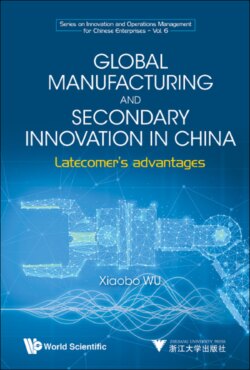Читать книгу Global Manufacturing and Secondary Innovation in China - Xiaobo Wu - Страница 14
На сайте Литреса книга снята с продажи.
1.2.1 Growth of inbound foreign investments fluctuates and its proportion gradually decreases
ОглавлениеSince the Reform and Opening-up, China’s foreign direct investment (FDI) has gone through a qualitative and quantitative growth. It greatly boosts the fast developments of China’s national economy. The fast growing economy, together with a huge labor market with cheap labor, an enormous market potential, the widened and deepened opening-up, plus the constantly improving investment environment, make China the most attractive investment destination. In the late 20th century, after the ramping-up stage between 1979 and 1986, the sustained growth from 1987 to 1991 and the high-speed development after 1992, foreign investment had gradually become the key ingredient of China’s economic development. After accession to the WTO in the 21st century, China’s foreign capital utilization has entered into the stage of innovative developments. Through constantly innovated foreign investment policies and utilization, institutional reform is undertaken to optimize the foreign investment environment. Robust and steady growth has been achieved in attracting foreign investment. In 2014, with a total foreign investment of USD 129 billion, China surpassed US for the first time and became the largest recipient of FDI (see Diagram 1-2).
Diagram 1-2 Actually utilized value of FDI, 2000–2015
Data Source: Statistical Communiqués of the People’s Republic of China on the National Economic and Social Development issued by China’s National Bureau of Statistics in 2000–2015.
Despite the generally rising trend of FDI, China’s manufacturing industry has seen major turbulence in its actually utilization of foreign capital over the 16 years between 2000 and 2015. As shown in Diagram 1-3, taking the year 2011 as the dividing line, even though occasional decline occurred, China’s manufacturing industry largely maintained an upward trajectory in attracting foreign capital before 2011. However, in the five consecutive years from 2011 to 2015, China’s manufacturing industry was hit by the slump of foreign investment, the annual amount of which dropped by 6.21%, 6.78%, 12.3% and 1.45% respectively. Likewise, after the year 2005, China’s manufacturing industry also saw a continuous decline of the proportion of its utilized foreign investments. The main reasons for the waning attractiveness of China’s manufacturing industry to foreign investment are as follows. Firstly, the gradually fading cost advantages of labor, land, energy and other production factors crippled the ability of China’s manufacturing industry to attract cost-oriented investment, leading to the withdrawal of a number of foreign firms. Secondly, at present, the severe overcapacity of China’s manufacturing industry posed mounting pressure on “capacity cutting”, transformation and upgrading of the industry. This also led to the withdrawal of some market-oriented foreign firms. Thirdly, with the boosted domestic demand of China’s economy and the implementation of policies and measures promoting emerging industry of strategic importance, many foreign firms investing in China’s heavy manufacturing industry started to move out of China. Finally, after the eruption of financial crisis, developed countries scrambled to issue many preferential policies to encourage the re-shoring of their manufacturing sectors and the shoring up of employment, aggravating the decline of foreign investment in China’s manufacturing industry (see Table 1-1, Diagrams 1-3 and 1-4).
Table 1-1 Foreign-invested projects and foreign capital actually utilized in China’s manufacturing industry, 2000–2015
Data Source: China’s Statistical Yearbook and Statistical Communiqués of the People’s Republic of China on the National Economic and Social Development issued by China’s National Bureau of Statistics in 2000–2015.
Diagram 1-3 FDI actually utilized in China’s manufacturing industry, 2000–2015
Data Source: Statistical Communiqués of the People’s Republic of China on the National Economic and Social Development issued by China’s National Bureau of Statistics in 2000–2015.
Diagram 1-4 Proportion of FDI actually utilized in China’s manufacturing industry
Data Source: Statistical Communiqués of the People’s Republic of China on the National Economic and Social Development issued by China’s National Bureau of Statistics in 2000–2015.
